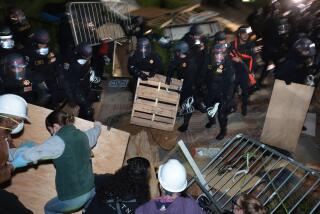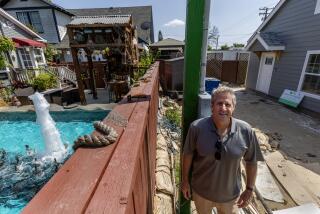LAX air traffic controllers to seek city panel’s help
For years, LAX air traffic controllers and the federal agency that manages them have argued about how many controllers are necessary to safely choreograph the 2,000 flights that ply the world’s fifth-busiest airfield each day.
The Los Angeles City Council’s Trade, Commerce & Tourism Committee will enter the debate today, when controllers testify that they believe that a staffing shortage in the LAX tower has contributed to a record number of close calls between planes on the ground since 2001.
The council has no jurisdiction in the matter -- controllers are hired and regulated by the Federal Aviation Administration.
Even so, Councilman Bill Rosendahl requested the presentation after a federal study found overworked controllers contributed to a nationwide jump in the rate of incidents in which planes violate safety zones around runways.
“I hope to create a federal outcry in Washington,” Rosendahl said. “Why do we have less personnel working longer hours as we increase the number of airplanes?”
The Dec. 5 study by the Government Accountability Office concluded that Los Angeles International Airport led the nation in close calls over the last eight years, including those that were considered most serious. It also prompted federal legislators who represent communities around LAX to demand that the FAA take action.
“The FAA must also increase the number of certified controllers in the LAX tower in order to improve individual controller readiness,” wrote Rep. Jane Harman (D-Venice) to Acting FAA Administrator Robert Sturgell earlier this month.
The accountability office’s findings reawakened the long-standing staffing debate at LAX and prompted the city’s Board of Airport Commissioners to call on officials to expedite plans to rework the two parallel runways on the north side, where several of the more serious safety incidents in the last 18 months occurred.
Airport officials and the FAA contend that they must move the northern runways farther apart. Residents of Westchester, which hugs the airport’s northern boundary, fear that such a move would increase noise and pollution. They argue that other measures, such as installing lights that warn a pilot if a runway is occupied and hiring more controllers, are cheaper and easier safety fixes.
Close calls generally have occurred at LAX when planes that land on the outer runways come too close to the inner runways, used for takeoffs, as they make their way to the terminals on a series of taxiways. Officials are completing a reworking of the two runways and taxiways on the airport’s south side, but have been unable to forge consensus on a solution for improving safety on the north side.
The controllers union found in a recent study of LAX that short staffing contributed to an increase in close calls on the ground. In 2000, 2001 and 2007, when fewer controllers were in the tower, the number of runway safety violations increased, on average, by nine per year, the report concluded.
“The staffing crisis is the No. 1 issue impacting safety on the airport today,” said Mike Foote, a controller in the LAX tower and a spokesman for the National Air Traffic Controllers Assn., who will testify before the council committee.
Thirty-three controllers work in the tower today, compared to about 46 in the years when fewer close calls occurred, Foote said.
Controllers must work an average of 2.3 overtime shifts a month to compensate, he said.
The FAA disagreed that the LAX tower is understaffed.
The union’s study “offers not a shred of evidence that any runway incursion at LAX was due to controller staffing,” said Ian Gregor, an agency spokesman.
FAA statistics show that the rate of close calls fell in the years there were fewer controllers, he said. In 2003, there were 2.6 such incidents per 100,000 operations with 50 controllers in the tower; in 2006, the rate dropped to 1.7 and there were 40 controllers, he said.
There are 34 certified controllers in the tower today and 11 additional personnel that can work some of the positions, Gregor said.
In addition, about 80% of the close calls at LAX since 2000 were due to pilot error, not issues with controllers, he said.
But Foote countered that alert controllers can help prevent pilot mistakes by catching them before they lead to runway safety violations.
--
More to Read
Start your day right
Sign up for Essential California for news, features and recommendations from the L.A. Times and beyond in your inbox six days a week.
You may occasionally receive promotional content from the Los Angeles Times.






